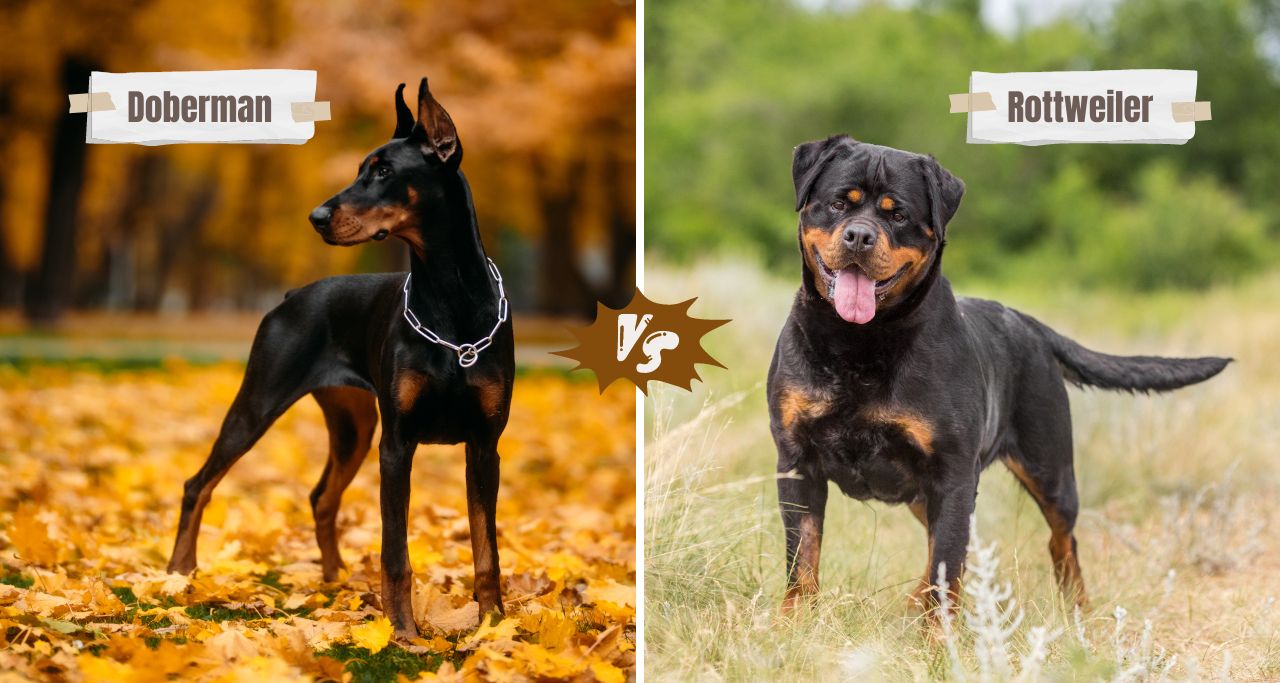
The Doberman and the Rottweiler are two of the world’s most iconic and recognizable dog breeds, often revered for their strength, loyalty, and protective instincts.
These two dog breeds have carved their own niches in the world of guard dogs, being entrusted with the safety of homes and families. But what sets them apart from each other, and what common traits do they share?
In this article, we will explore the fascinating histories of these two breeds, their unique physical attributes, temperaments, training needs, health considerations, ideal living environments, and more! As two breeds with distinct characteristics and needs, understanding their differences and similarities is crucial for any potential owner.
Whether you’re looking to adopt one of these breeds or simply curious about their unique attributes, this comprehensive guide will provide you with all the information you need to make informed decisions or satisfy your curiosity about these remarkable dogs, with comparison tables for easy reference.
| Breed Comparison | Doberman Pinscher | Rottweiler |
|---|---|---|
| Weight | 60 - 100 pounds | 80 - 135 pounds |
| Height | 24 - 28 inches | 22 - 27 inches |
| Size | Medium to large | Large |
| Temperament | Alert, intelligent, fearless | Loyal, protective, courageous |
| Trainability | 4.0 out of 5.0 stars4.0 | 4.0 out of 5.0 stars4.0 |
| Energy Level | 4.0 out of 5.0 stars4.0 | 4.0 out of 5.0 stars4.0 |
| Life Expectancy | 10 - 12 years | 9 - 10 years |
| Shedding | 2.0 out of 5.0 stars2.0 | 3.0 out of 5.0 stars3.0 |
| Hypoallergenic | No | No |
| Puppy Costs | $1,500 - $2,500 | $1,500 - $4,000 |
| Suitable For | A Doberman Pinscher is an excellent match for those seeking a deeply devoted and attentive guardian. Dobies are particularly attuned to their owner's emotions and thrive in more quiet and stable environments where their heightened sensitivity is not constantly tested by excessive commotion or upheaval. | A Rottweiler is best suited for an owner who appreciates a confident, independent, protective breed and can provide firm and consistent training. Rotties are well-equipped to handle more active households and dynamic environments, as they tend to be more adaptable and less affected by changes in their surroundings. |
Origins and History: Doberman vs. Rottweiler
Doberman
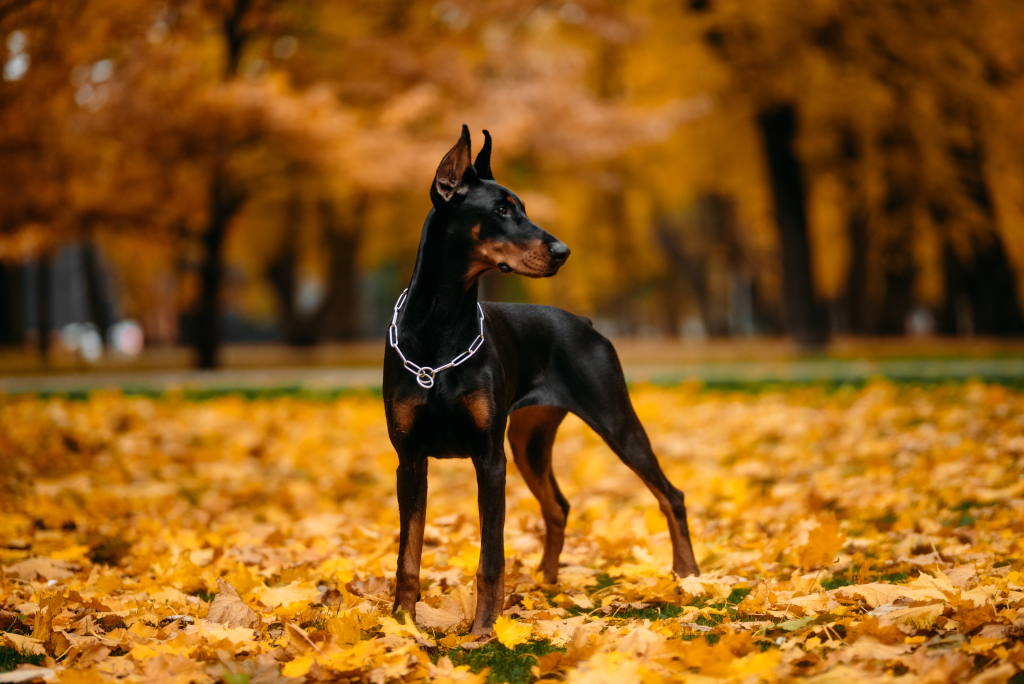
The Doberman breed has a relatively short history, originating in Germany in the late 19th century. The breed was named after a tax collector, Karl Friedrich Louis Dobermann, who desired a loyal, protective, and intelligent breed to accompany him during his work.
The breed was developed by crossing several dog breeds, including the Rottweiler, Black and Tan Terrier, and the German Pinscher, with the intention of creating a versatile and fearless working dog. As a result, the Doberman quickly gained a reputation for being a loyal guardian.
During both World Wars, Dobermans were used extensively as sentries, messengers, and search and rescue dogs. Today, the Doberman is known for its intelligence, alertness, loyalty, and fearlessness, making it a popular choice for police work, search and rescue, and personal protection.
Rottweiler

The Rottweiler dog breed has a much longer history, dating back to ancient Roman times. The breed’s ancestors were likely Roman drover dogs, used for herding and protecting livestock.
As the Roman Empire expanded, these dogs were brought to what is now modern-day Germany. In the town of Rottweil, the breed was further developed and refined, eventually taking on the name “Rottweiler.” Rottweilers were primarily used for herding and as guard dogs, protecting livestock from predators and thieves.
In the early 20th century, the breed’s strength and intelligence were recognized, leading to their use in police and military roles. Rottweilers served as messenger dogs, guard dogs, draft dogs, and search and rescue dogs during both World Wars.
Today, the breed is known for its strength, loyalty, and protective instincts, making it a popular choice for personal protection and security work.
| Attribute | Doberman | Rottweiler |
|---|---|---|
| Origin | Germany, late 19th century | Ancient Rome, developed in Rottweil, Germany |
| Original Purpose | Personal protection, guard dog | Herding, guarding livestock |
| Early Uses | Sentries, messengers, search and rescue during World Wars | Messengers, guard dogs, draft dogs, search and rescue during World Wars |
| Modern Roles | Family pets, police work, personal protection, search and rescue | Family pets, personal protection, security work, herding |
| Key Traits | Intelligence, alertness, loyalty | Strength, loyalty, protective |
| Year Recognized by the American Kennel Club | 1908 | 1931 |
** Comparison Table: Doberman vs. Rottweiler - Historical Background
Comparing Physical Appearance and Characteristics
Doberman
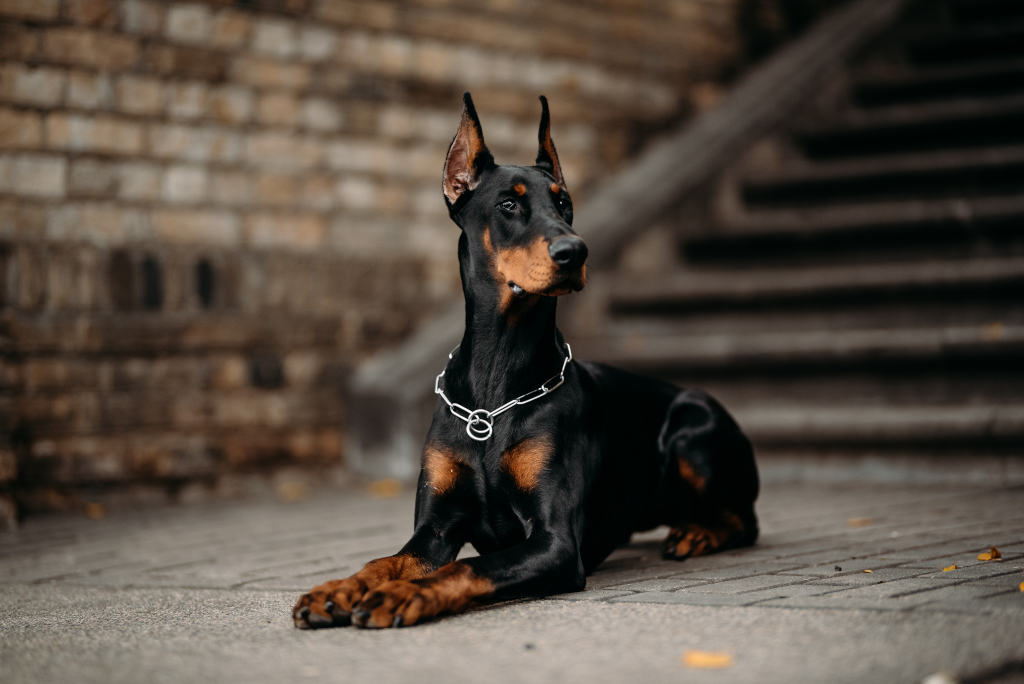
The Doberman is a medium to large-sized dog with a strong, muscular, and sleek build. Known for their agility and speed, they have a square, compact body shape that allows for quick, precise movements.
Males typically stand between 26 to 28 inches tall at the shoulder, while female Dobies stand between 24 to 26 inches.
In terms of weight, males usually weigh between 75 to 100 pounds, while females weigh between 60 to 90 pounds.
They have a short, smooth, and dense single coat that comes in several colors, including black, red, blue, and fawn (a light tan color), all with rust markings on the face, chest, and legs. Some Dobermans may also have a white patch on the chest.
Rottweiler
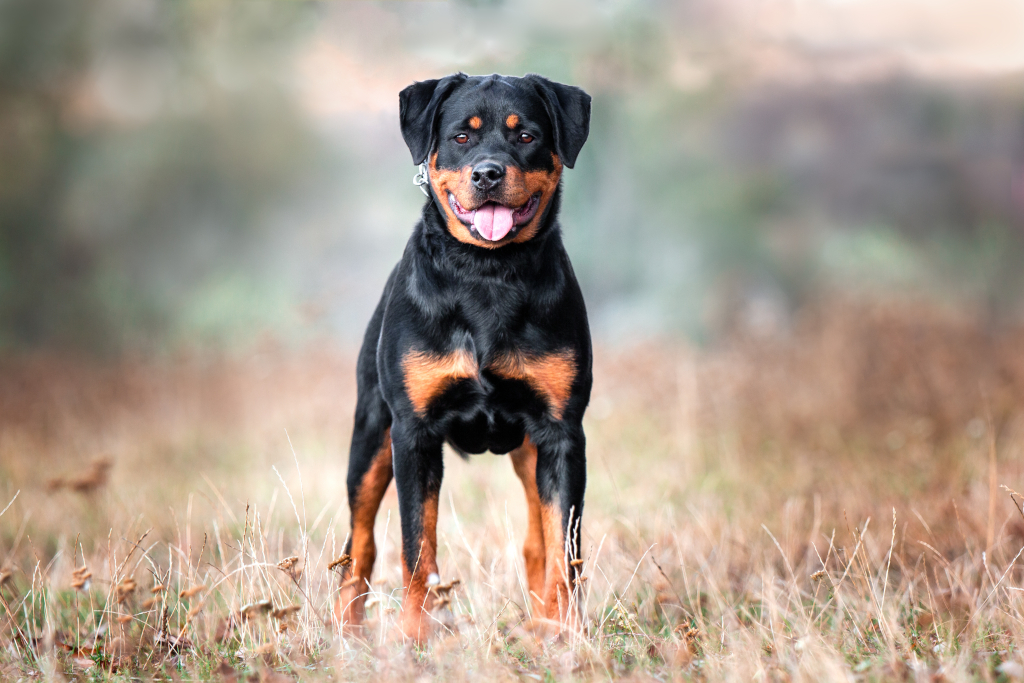
The Rottweiler is a large, robust, powerful dog breed with a stocky, well-muscled build that lends them great strength and endurance.
Males stand between 24 to 27 inches tall, and female Rotties stand between 22 to 25 inches.
As for weight, males usually weigh between 95 and 135 pounds, while females weigh about 80 to 100 pounds.
They have a short, dense, straight coat with an undercoat. The breed’s coat is primarily black with well-defined rust, mahogany, or tan markings on the cheeks, muzzle, paws, and legs. The markings are a distinct feature of the breed and are usually symmetrical.
| Attribute | Doberman | Rottweiler |
|---|---|---|
| Size | Medium to large | Large |
| Male Height | 26 to 28 inches | 24 to 27 inches |
| Male Weight | 75 to 100 pounds | 95 to 135 pounds |
| Female Height | 24 to 26 inches | 22 to 25 inches |
| Female Weight | 60 to 90 pounds | 80 to 100 pounds |
| Build | Strong, muscular, sleek | Robust, powerful, well-muscled |
| Coat Type | Short, smooth, dense single coat | Short, dense, straight double coat |
| Coat Colors | Black, red, blue, fawn with rust markings | Black with rust, mahogany, or tan markings |
** Comparison Table: Doberman vs. Rottweiler - Physical Attributes
Temperament and Personality
Doberman
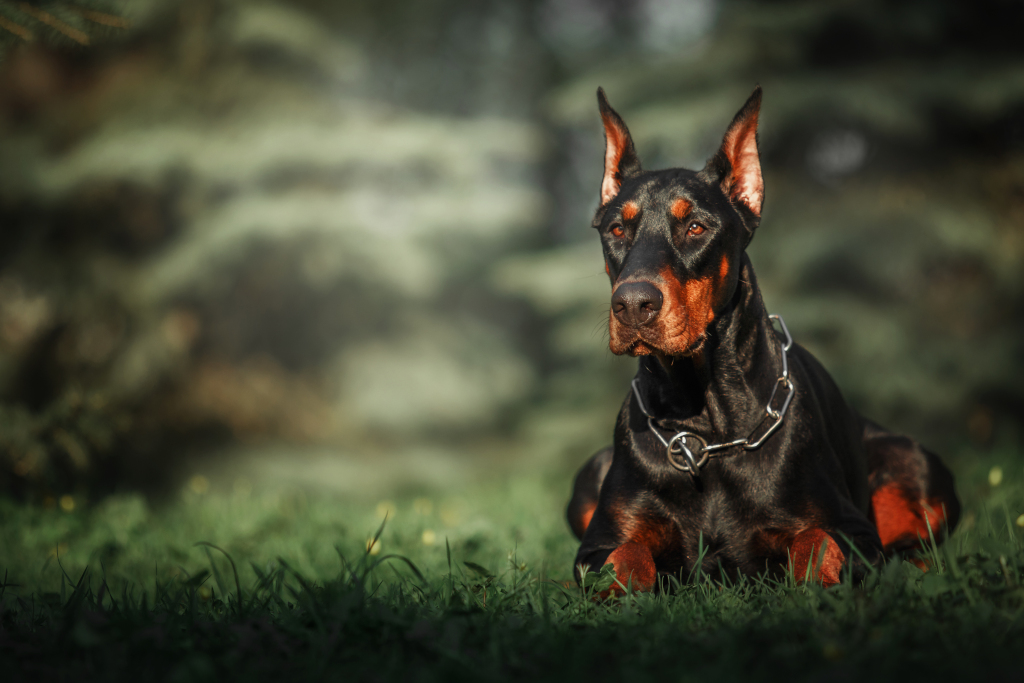
Meet the Doberman, a dog that combines intelligence, loyalty, and a protective nature into a sleek and muscular package. Imagine a dog that is not only a quick learner but also excels in obedience and agility competitions. That’s the Doberman for you!
With their natural alertness and vigilance, Dobermans make excellent guard dogs, always ready to defend their families. And don’t be surprised if they are a bit wary of strangers; it takes time for them to warm up to new people. Early socialization is a must to ensure they are well-adjusted.
They have a soft side, too – they are affectionate and devoted to their families, forming strong bonds with their owners.
In fact, they are often referred to as velcro dogs because they’ll likely be following you around the house all day! Because of their need to be close to their owners, Dobies don’t do well when left alone for long periods of time and can develop separation anxiety.
Rottweiler
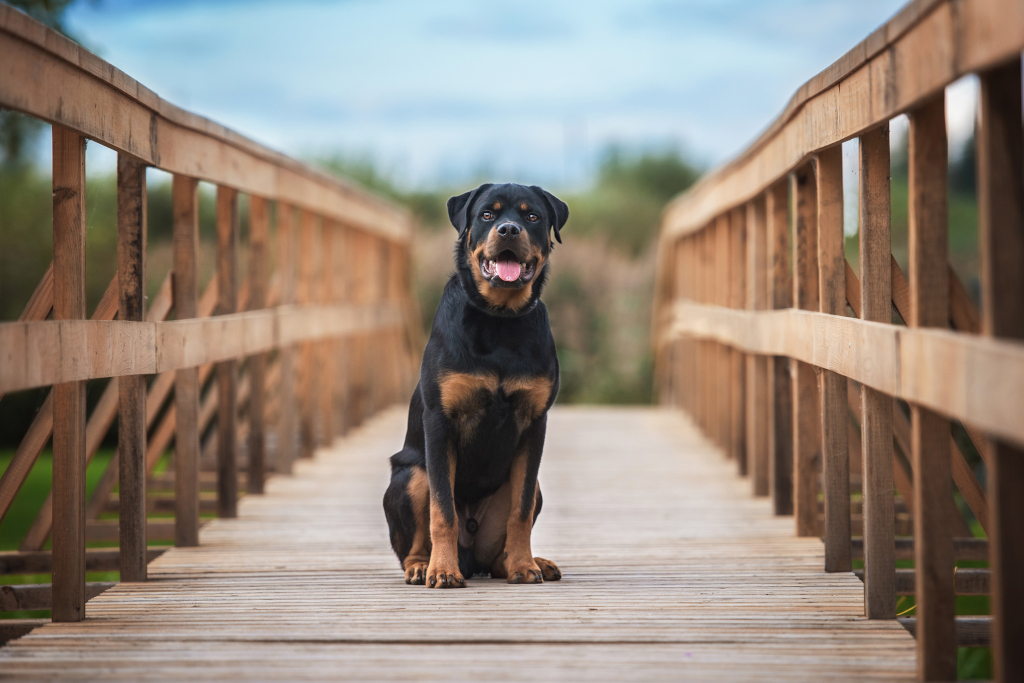
The embodiment of strength, courage, and confidence in the dog world, the Rottweiler is a dog that is always on guard, ready to defend its territory and protect its family.
These powerful protectors are fiercely loyal to their families, showing their playful and affectionate side to those they trust. They are quick learners and highly trainable, but they need a strong hand to guide them.
They usually get along well with children and other pets, but their size and strength mean that supervision is always a good idea. Rottweilers may appear aloof or reserved with strangers, but early socialization can help them become well-adjusted adults.
| Attribute | Doberman | Rottweiler |
|---|---|---|
| Protection | Excellent watchdog and guard dog | Natural protector |
| Behavior with Strangers | Wary of strangers, requires socialization | Aloof or reserved, requires socialization |
| Behavior with Children | Generally good, supervision advised | Generally good, supervision advised |
| Overall Temperament | Alert, intelligent, loyal | Loyal, courageous, confident |
** Comparison Table: Doberman vs. Rottweiler - Temperament and Personality
Energy Level and Exercise Needs
Doberman
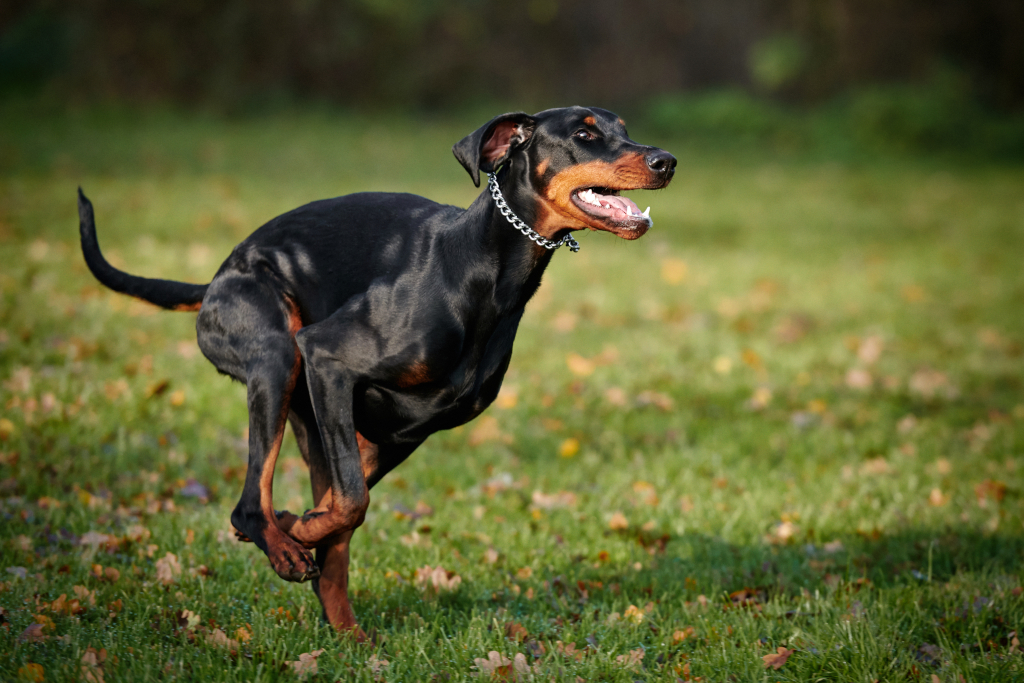
The Doberman, a canine dynamo that never runs out of energy, these spirited dogs come with a need for speed and activity. With their high energy levels, Dobermans require about 1 to 1.5 hours of exercise per day to keep them happy and healthy.
Whether it’s an intense game of fetch, a brisk jog, sprinting through an open field, chasing after a frisbee, conquering an agility course, or simply going on a long walk, Dobermans thrive when they have the opportunity to unleash their boundless energy.
You May Also Like: Ultimate Guide to Running with Dogs
Rottweiler
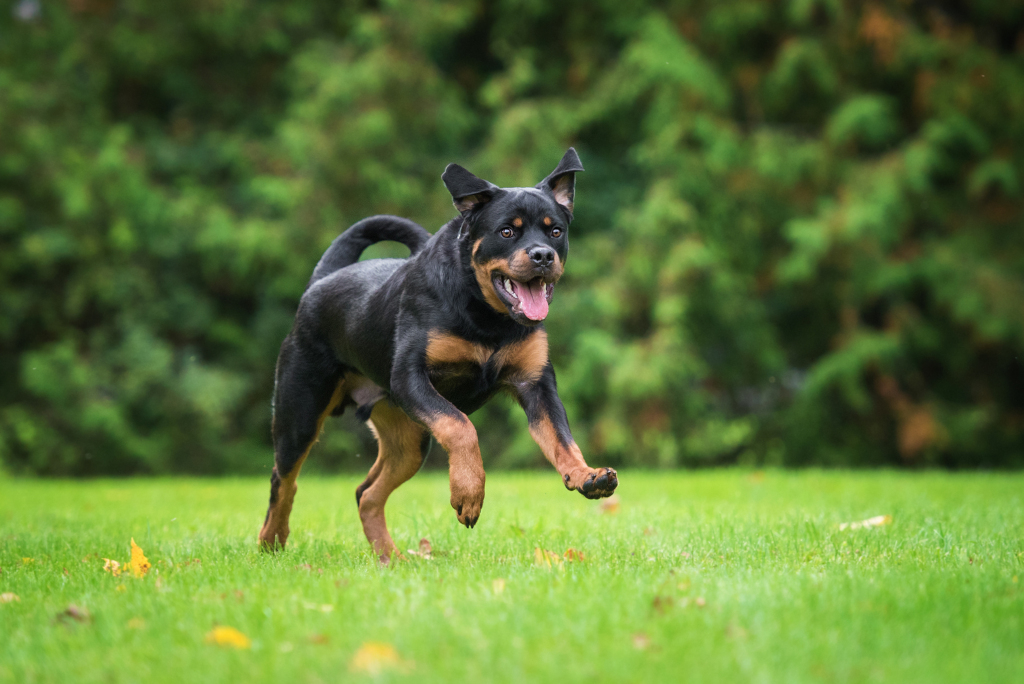
Despite their robust and muscular build, Rottweilers are more moderate in their energy levels compared to Dobies. These dogs require a minimum of an hour of exercise per day to keep them in top condition.
These loyal companions enjoy activities that engage their body and mind, such as obedience training, tug-of-war, or even a leisurely walk. Although they may not have the same boundless energy as a Doberman, Rottweilers still need regular exercise to maintain their physical health and mental well-being.
You May Also Like: Tips for Training Your Dog to Run With You Without a Leash
| Attribute | Doberman | Rottweiler |
|---|---|---|
| Energy Level | High | Medium to high |
| Exercise Needs (Per Day) | 1 to 1.5 hours | 1 hour |
** Comparison Table: Doberman vs. Rottweiler - Energy Level and Exercise Needs
Note: Both the Rottweiler and Doberman can become bored, frustrated, and destructive if they don't get enough exercise, so make sure to provide them with the physical and mental stimulation they need to lead happy and fulfilled lives.
Training and Socialization
Doberman
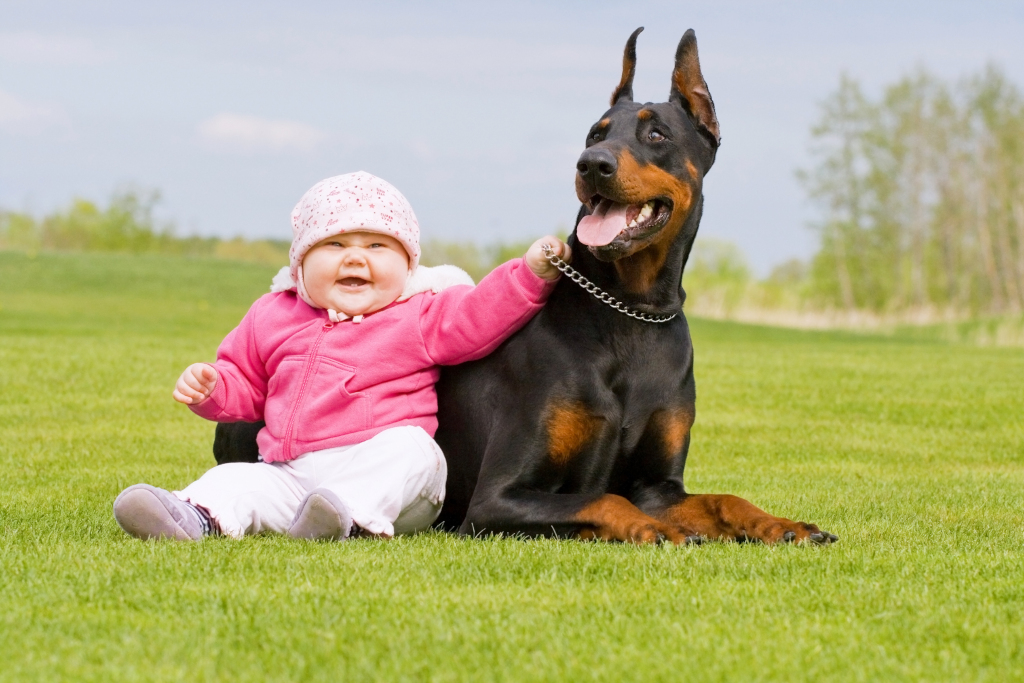
It’s important to emphasize that this breed thrives on structured, reward-based training. Their sharp intellect makes them fast learners, readily responding to positive reinforcement such as treats, praise, and play.
However, it’s not just about proper training sessions; Dobermans need extensive socialization from a young age. They have a natural suspicion of strangers, which can be mitigated by exposing them to diverse environments and people early on.
While they’re eager to please, their protective instincts require clear leadership and boundaries to ensure they don’t become overly assertive.
You May Also Like: What is Clicker Training & How Does it Work?
Rottweiler

On the other hand, the Rottweiler is a strong-willed breed that benefits from firm yet fair training. They’re highly intelligent and capable of mastering commands quickly, but consistency and clear boundaries are key.
Reward-based training methods work well for Rottweilers, building trust and respect between owner and dog.
Socialization is equally crucial for this breed, as they can be reserved or aloof with strangers. Early exposure to various situations, people, and places will help them grow into confident, well-adjusted adults.
And just like the Doberman, proper leadership is essential to channel their protective instincts positively.
You May Also Like: 7 Most Popular Dog Training Techniques
| Attribute | Doberman | Rottweiler |
|---|---|---|
| Training Approach | Positive reinforcement, clear leadership | Consistent, reward-based, firm handling |
| Socialization Needs | High, diverse exposure | High, varied experiences |
** Comparison Table: Doberman vs. Rottweiler - Training and Socialization
Health and Lifespan
Doberman
On average, Dobies live 10 to 12 happy and active years. And when it comes to the Doberman’s health, these sleek and powerful dogs have their own unique set of health concerns to watch out for.
Hip dysplasia, dilated cardiomyopathy, and von Willebrand’s disease are among the most common issues.
Rottweiler
With its strong and muscular build, the mighty Rottweiler typically enjoys 9 to 10 years of loyal companionship and comes with a few health issues to be mindful of.
This breed may experience hip and elbow dysplasia, heart problems, or even certain types of cancer.
You May Also Like: Reasons Why Your Dog is Restless at Night
| Attribute | Doberman | Rottweiler |
|---|---|---|
| Lifespan | 10 to 12 years | 9 to 10 years |
| Common Health Concerns | Hip dysplasia, dilated cardiomyopathy, von Willebrand's disease | Hip and elbow dysplasia, heart problems, certain types of cancer |
** Comparison Table: Doberman vs. Rottweiler - Health and Lifespan
Note: Both these breeds are generally healthy dogs, but it is important to stay up-to-date with your pet's health records. Keeping track of their vaccinations and establishing a routine veterinary visit schedule can help you quickly identify any potential issues that may arise. Early diagnosis and treatment are key to ensuring the best quality of life for your beloved canine companion!
Nutrition and Diet: Rottweiler vs. Doberman
Doberman
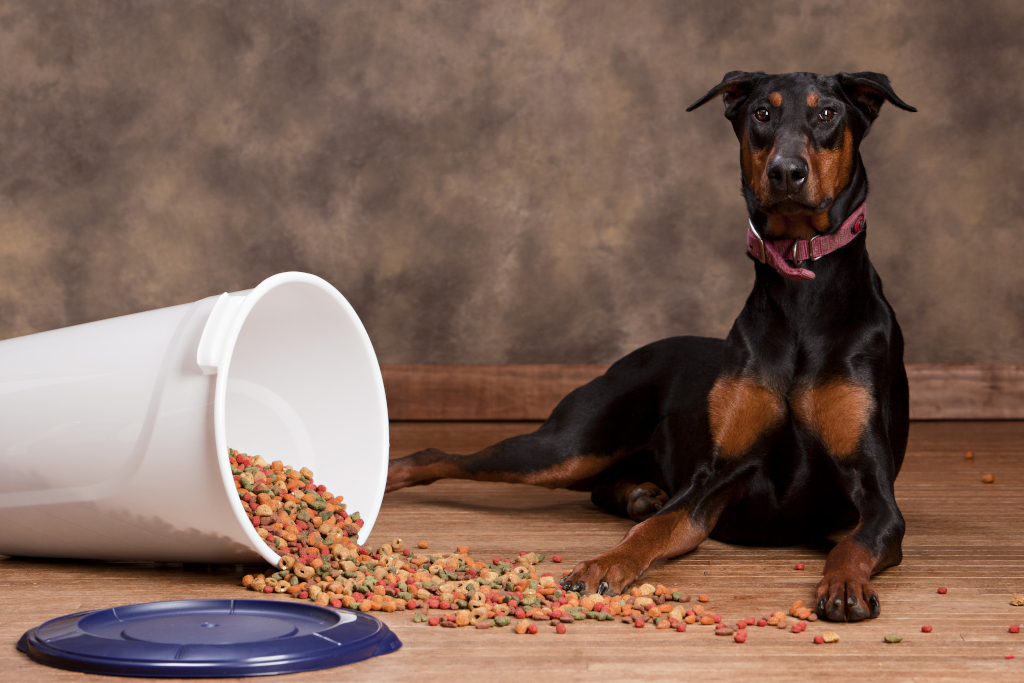
Properly feeding your sleek and active Doberman is essential for its health and well-being. An adult Doberman typically requires between 4 and 7 cups of high-quality kibble daily.
However, the specific amount can vary based on factors such as the dog’s size, age, and activity level. It’s crucial to tailor their diet to their unique requirements – after all, each Doberman is one-of-a-kind!
Rottweiler
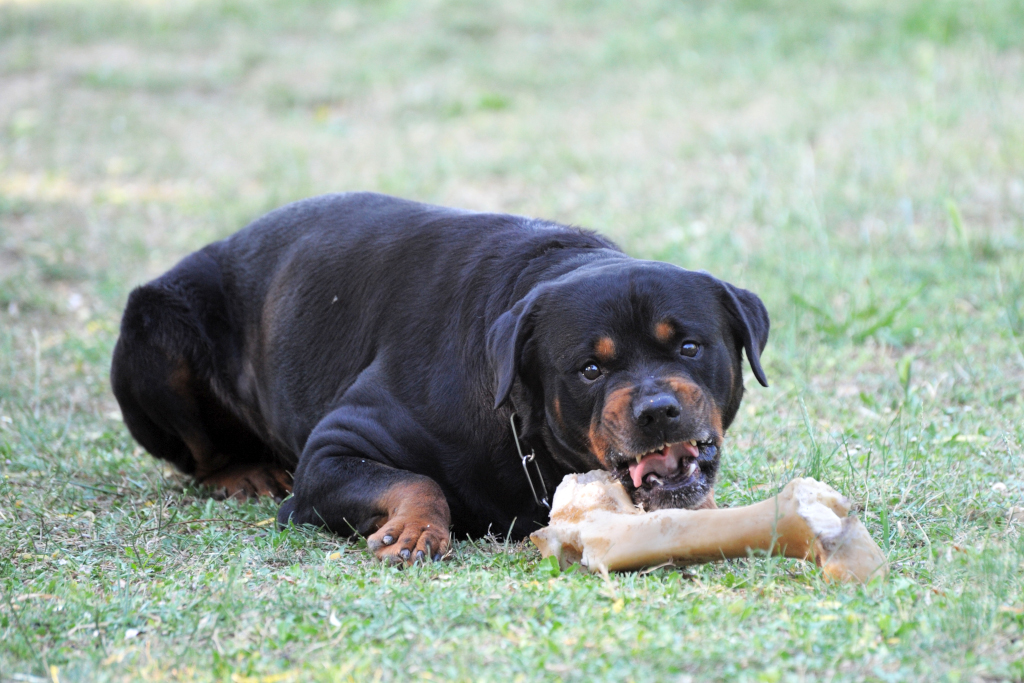
The sturdy Rottweiler needs a diet that supports its powerful build and nutritional needs. Generally, an adult Rottweiler should receive about 3 to 5 cups of high-quality kibble each day.
Keep in mind that the perfect portion size for your Rottweiler depends on their size, age, and how active they are. No two Rotties are the same, so it’s essential to consider their specific needs when deciding on their daily intake.
You May Also Like: Common Reasons Why Your Dog Won’t Eat
| Attribute | Doberman | Rottweiler |
|---|---|---|
| Average Daily Kibble Intake | 4 to 7 cups | 3 to 5 cups |
** Comparison Table: Doberman vs. Rottweiler - Nutrition and Diet
Grooming Needs: Doberman Pinscher vs. Rottweiler
Doberman
The Doberman, with its short, sleek coat, is a relatively low-maintenance breed when it comes to grooming.
They need weekly brushing to remove loose hair and keep their coat looking shiny.
Additionally, bathing is only necessary every 2 to 3 months or when they get particularly dirty. Dobermans also require regular ear cleaning, nail trimming, and dental care to maintain their overall health.
With their minimal grooming needs, Dobermans are perfect for those who prefer a low-fuss canine companion.
You May Also Like: Best Dog Ear Cleaners
Rottweiler
The Rottweiler, boasting a short and dense coat, also has minimal grooming needs.
They, too, require a weekly brush to remove loose hair and distribute natural oils across their coat, though their shedding will intensify in the spring and fall, which requires a little extra attention.
Like Dobes, bathing is usually only necessary every 2 to 3 months or as needed when they get dirty. Regular ear cleaning, nail trimming, and dental care are essential to keeping your Rottie healthy and comfortable.
You May Also Like: Best Waterless Dog Shampoos
| Attribute | Doberman | Rottweiler |
|---|---|---|
| Shedding Amount | Moderate | Moderate but slightly heavier in spring and fall |
| Brushing Frequency | Weekly | Weekly but more frequently during the shedding season |
| Bathing Frequency | Every 2-3 months or when dirty | Every 2-3 months or when dirty |
** Comparison Table: Doberman vs. Rottweiler - Grooming Needs
Which Breed is Better For You? Doberman Pinscher or Rottweiler?
Both the Doberman Pinscher and the Rottweiler are loyal, intelligent, and protective, making them excellent protectors of their homes and families. However, their temperaments and characteristics vary, which can impact their suitability for different lifestyles.
Rottweilers are typically more laid-back compared to Dobies, making them a better choice for families with children or other dogs. They also tend to be more relaxed in new situations and can be more easily socialized.
On the other hand, Doberman Pinschers have a higher energy level, requiring more mental and physical stimulation. They are agile and alert and thrive in an environment where they can exercise and be mentally engaged.
Frequently Asked Questions About Doberman vs. Rottweiler
Q1: Which breed is stronger? Doberman or Rottweiler?
A: Rottweilers are generally stronger than Dobermans in terms of physical strength. Rottweilers are built for power and endurance, with a muscular frame and sturdy build.
Q2: Which breed is more aggressive? Doberman or Rottweiler?
A: Aggression largely depends on an individual dog’s upbringing, training, and socialization rather than their breed. That said, Dobermans are typically more protective than Rotties and may appear more aggressive when defending their families.
Q3: What is the bite force of a Doberman vs Rottweiler?
A: The bite force of a Rottweiler is higher than that of a Doberman. Rottweilers have a bite force of approximately 328 pounds per square inch (psi), while Dobermans have a bite force of around 305 psi. It’s crucial to note that these measurements can vary between individual dogs.

